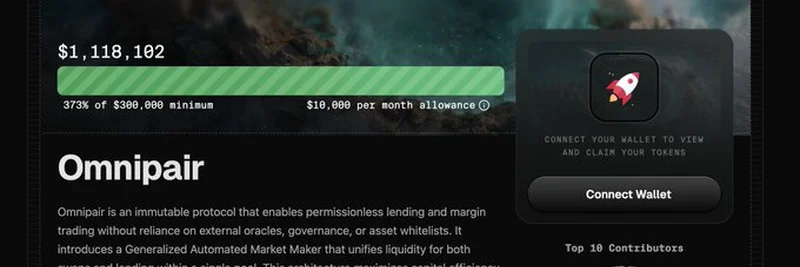If you’ve been keeping an eye on the crypto world, you might have noticed some exciting buzz around Omnipair’s recent Initial Coin Offering (ICO). On July 28, 2025, the X account Colosseum dropped a tweet celebrating Omnipair’s success, raising an impressive $1.1 million—373% of its $300,000 minimum goal. This milestone wasn’t just a win for Omnipair but also a shining example of how futarchy-driven ICOs, powered by MetaDAO, are changing the game. Let’s break it down and explore what this means for the future of decentralized trading.
What’s the Big Deal with Omnipair?
Omnipair isn’t your average crypto project. Built on the Solana blockchain, it’s a decentralized protocol designed for permissionless lending and margin trading. What sets it apart? It ditches the usual reliance on external oracles, governance committees, or asset whitelists. Instead, it uses a clever tool called a Generalized Automated Market Maker (GAMM). This system pools liquidity for both swaps and lending, maximizing capital efficiency in a way that’s perfect for those often-overlooked “long-tail” assets—think niche tokens that don’t get much love elsewhere.
The tweet’s attached image shows a sleek dashboard with a progress bar hitting $1,118,102, alongside a call to action to “Connect Wallet” and claim tokens. With 321 contributors and a $10,000 monthly allowance, it’s clear this project has community support behind it. You can dig deeper into the details on the Omnipair website or check out their blackpaper for the nitty-gritty.
The Futarchy Factor
So, what’s futarchy, and why does it matter? Simply put, futarchy is a governance model that uses prediction markets to make decisions. Instead of relying on votes or a small group of developers, it lets participants bet real money on the outcomes they believe in. The idea is that financial stakes sharpen predictions, leading to smarter choices. The Ethereum Foundation Blog has a great intro to this concept, explaining how it could outshine traditional governance models.
In Omnipair’s case, MetaDAO harnessed futarchy to guide the ICO, connecting smart investors with innovative projects. The tweet from Colosseum praises this approach, and the follow-up comments from users like Z and Alexander Sleuth echo the sentiment—futarchy seems to be working! This success could pave the way for more projects to adopt this model, especially on platforms like Solana that prioritize speed and low costs.
Why This Matters for Meme Token Fans
At Meme Insider, we’re all about keeping you in the loop on the latest blockchain trends, especially those that might influence meme tokens. While Omnipair itself isn’t a meme coin, its innovative approach to trading and lending could inspire new meme token projects. Imagine a meme coin with built-in leverage or community-driven liquidity pools—futarchy could be the key to making that happen. Plus, with Solana’s growing ecosystem, we might see more meme tokens leveraging similar tech in the future.
What’s Next for Omnipair?
With the ICO wrapped up, Omnipair is gearing up for its next phase. The project’s autonomous design, governed by code rather than committees, promises a smooth rollout. If you’re intrigued, follow Omnipair on X or dive into their docs to stay updated. The community’s enthusiasm, as seen in the 321 contributors, suggests this is just the beginning.
In short, Omnipair’s futarchy-driven ICO is a bold step forward for decentralized finance (DeFi). It’s not just about the $1.1 million raised—it’s about proving a new way to build and fund blockchain projects. Whether you’re a crypto newbie or a seasoned trader, this is one to watch. What do you think—could futarchy be the future of ICOs? Drop your thoughts in the comments!


